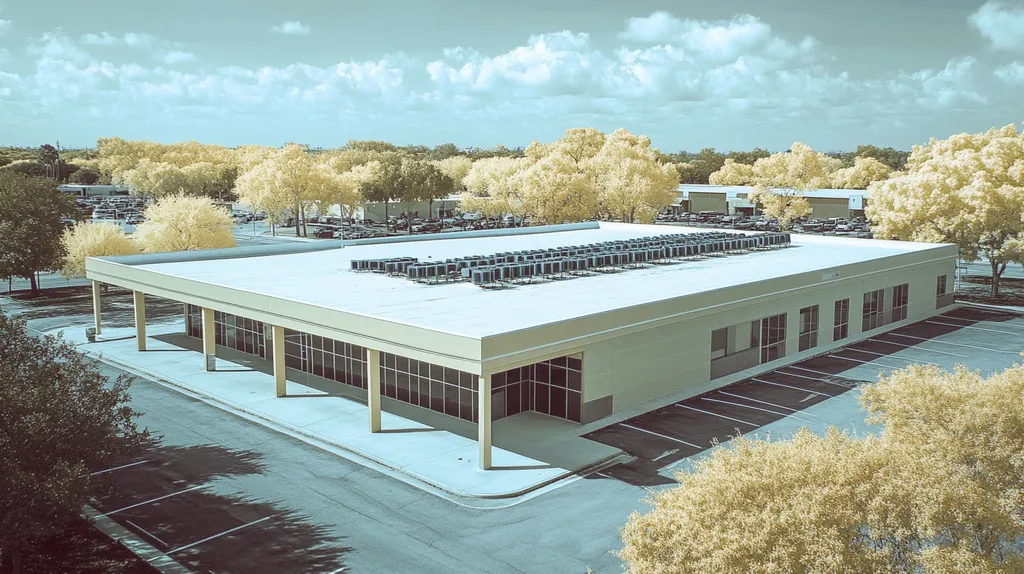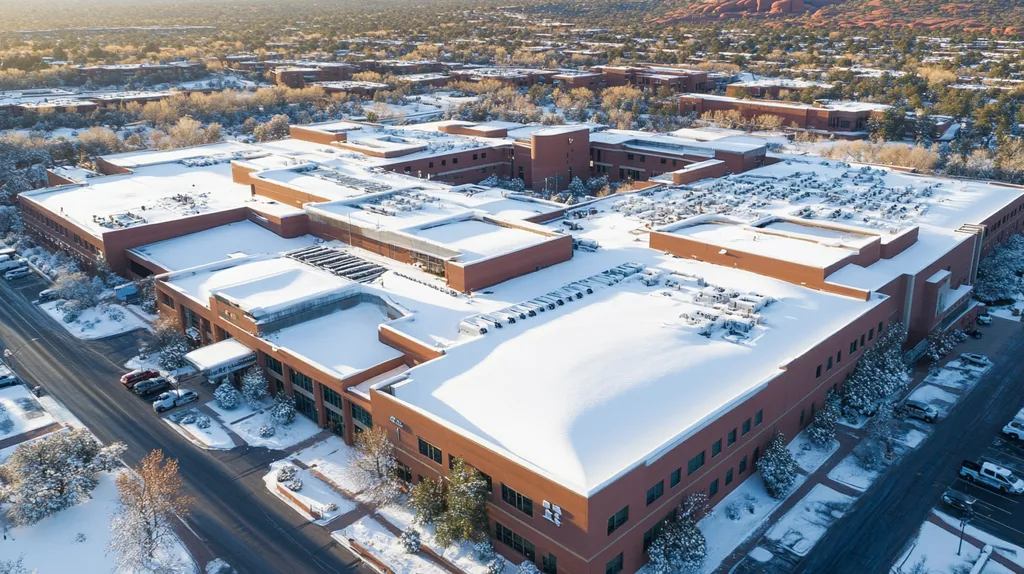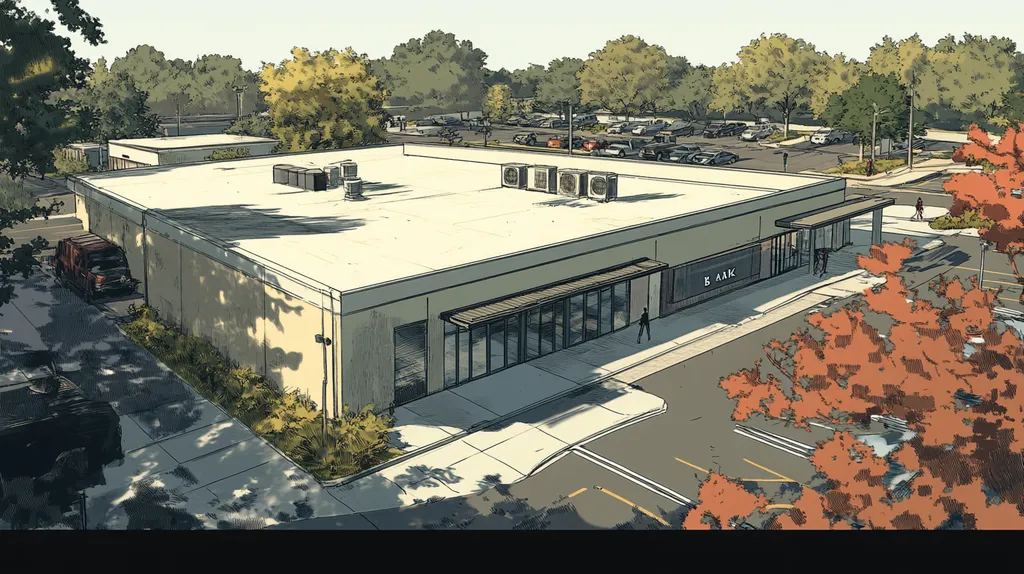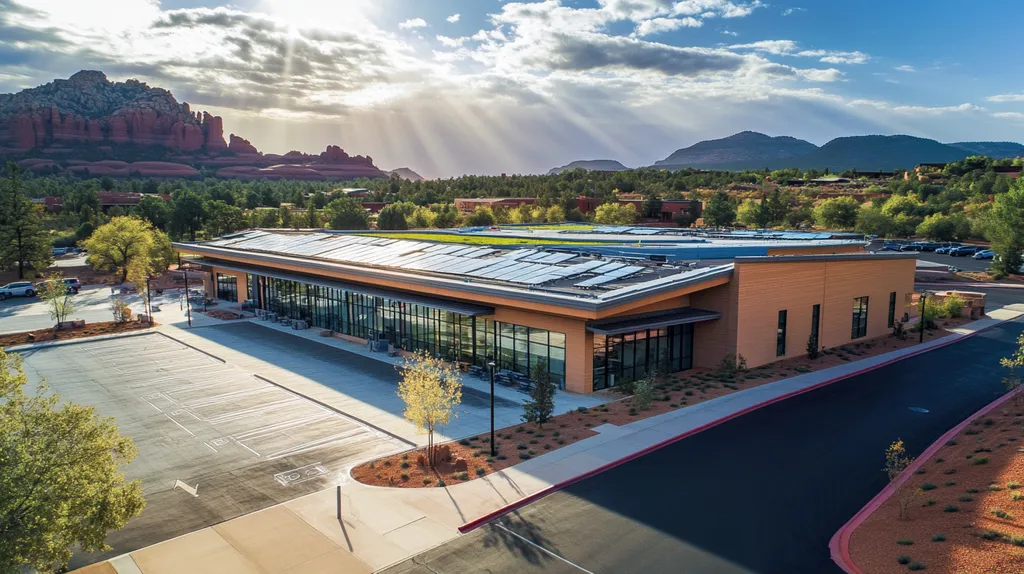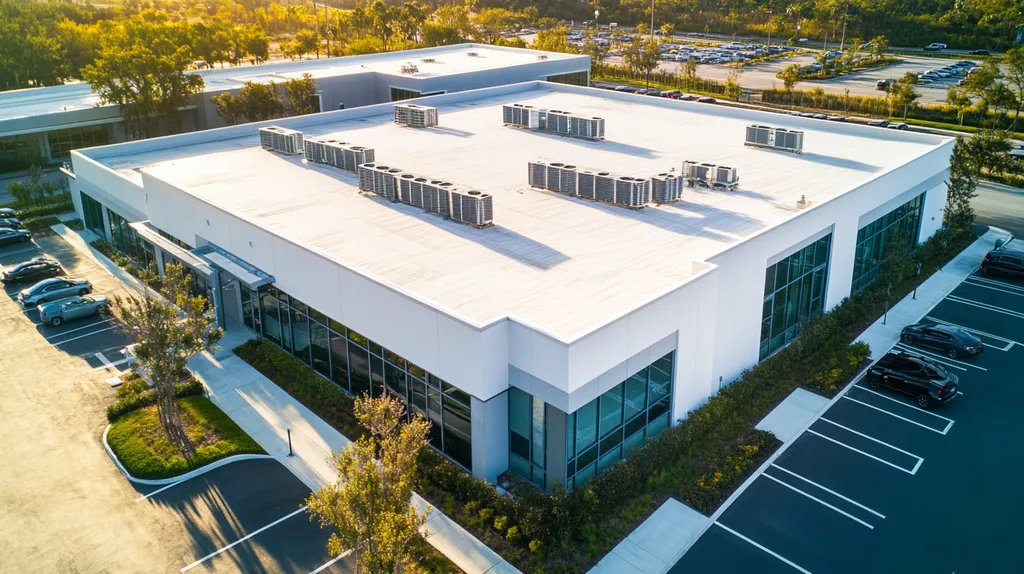Welcome to today’s Battle Royale featuring two roofing heavyweights: “Quarterly Inspections” in the east corner versus “Biannual Inspections” in the west!
Tonight’s showdown pits these contenders against each other across six punishing rounds designed to test every aspect of their performance for Commercial Roof Maintenance.
At stake? Millions in potential costs, decades of building protection, and the critical performance demands of modern commercial and industrial facilities.
Our professional judging panel will evaluate each round on technical merit, real-world performance, and value delivery. After all six rounds, we’ll declare our ultimate champion.
Ladies and gentlemen, facility managers and building owners… it’s time to rumble!
ROUND 1: INITIAL COSTS & INSTALLATION
Every commercial roofing project starts with critical decisions about materials, installation methods, and timelines that impact decades of performance. When a roof fails prematurely, replacement costs can surge to $15-25 per square foot – often two to three times the cost of proper initial installation. Understanding how inspection frequency influences these foundational choices can mean the difference between a roof that lasts 30 years and one that needs replacement after just 15.
Material Expenses
Material selection forms the foundation of any commercial roofing system, with costs varying dramatically based on quality and type. Premium materials specified during quarterly inspections typically cost 20-30% more upfront but offer superior resistance to weathering, UV exposure, and mechanical stress.
Quarterly inspection protocols emphasize selecting materials that maximize longevity and minimize lifecycle costs. These programs often identify opportunities to use advanced materials like reinforced TPO or multi-ply modified bitumen systems that extend roof lifespans.
Biannual inspection schedules tend to focus on immediate cost savings, sometimes leading to the selection of basic materials that require more frequent replacement. This approach can result in higher long-term expenses due to more frequent repairs and shorter service life.
Based on material performance and lifecycle costs, quarterly inspections demonstrate a clear ADVANTAGE in this category.
Installation Complexity
Installation quality directly impacts a roof’s long-term performance and maintenance requirements. Quarterly inspection programs typically include pre-installation planning sessions that identify potential complications before work begins.
These more frequent inspections allow for detailed documentation of existing conditions and careful coordination of different trades. This systematic approach helps prevent common installation errors that could compromise roof integrity.
Biannual inspection schedules provide fewer opportunities to catch installation issues early. This reduced oversight can lead to shortcuts or improper techniques that create weak points in the roofing system.
With its emphasis on quality control and proper installation techniques, quarterly inspections gain another ADVANTAGE.
Project Timeline
The duration of a roofing project affects both direct costs and business disruption. Quarterly inspection programs excel at creating detailed project timelines that account for weather windows, material lead times, and crew availability.
These more frequent check-ins enable better coordination between property managers, contractors, and suppliers. Problems can be identified and addressed quickly, preventing costly delays.
Biannual inspections often result in less precise scheduling and longer project timelines. The extended gaps between inspections make it harder to anticipate and plan for potential complications.
The superior project management capabilities of quarterly inspections earn them an ADVANTAGE in timeline efficiency.
ROUND 1 WINNER: Quarterly Inspections
ROUND 2: DURABILITY & LIFESPAN
Every commercial roof faces constant threats from UV radiation, moisture intrusion, and thermal stress. These forces steadily degrade roofing materials and compromise structural integrity, making the frequency of professional inspections a critical factor in long-term performance. The difference between quarterly and biannual inspections can mean detecting issues when they’re minor versus discovering major damage that threatens business operations.
Weather Impact Assessment
Seasonal changes subject commercial roofs to dramatic temperature swings, precipitation, and wind forces. These environmental stresses cause materials to expand, contract, and potentially separate, creating entry points for moisture.
Quarterly inspections align perfectly with seasonal transitions, allowing technicians to evaluate how different weather patterns affect roof condition. This timing enables preventive measures before harsh conditions arrive and prompt repairs after severe weather events.
Biannual inspections often miss critical seasonal transition points, leaving roofs vulnerable during challenging weather periods. This reduced oversight means weather-related damage can go undetected for months, leading to compounding issues.
Given the superior ability to track and respond to weather impacts, quarterly inspections earn a clear ADVANTAGE.
Material Performance Monitoring
Regular assessment of roofing materials is essential for maintaining watertight integrity. Commercial roofs contain multiple components that can deteriorate at different rates, from membrane surfaces to flashings and sealants.
Quarterly inspections provide consistent tracking of material wear patterns and early warning signs of failure. This frequency allows for timely maintenance interventions that extend material lifespan and prevent cascading damage.
While biannual inspections may catch major material failures, they frequently miss subtle degradation indicators. This gap in monitoring can allow small issues to develop into significant problems requiring extensive repairs.
With more opportunities to optimize material performance, quarterly inspections secure another ADVANTAGE.
System Longevity Factors
Commercial roofs typically have an expected service life of 20-30 years when properly maintained. Regular inspections play a crucial role in achieving or exceeding these projections by identifying and addressing maintenance needs promptly. While there is no universal mandate for inspection frequency, factors like severe weather events, roof age, and recent construction activities often necessitate more frequent evaluations. (source: New Image Roofing Atlanta)
Quarterly inspections create a comprehensive maintenance record that helps predict and prevent system failures. This proactive approach typically extends roof lifespan by catching problems before they affect underlying structure.
Biannual inspections provide less detailed tracking of system performance over time. This reduced oversight can lead to shortened lifespans as maintenance opportunities are missed and problems compound between inspections.
For maximizing system longevity, quarterly inspections demonstrate a clear ADVANTAGE.
ROUND 2 WINNER: Quarterly Inspections
ROUND 3: PERFORMANCE FACTORS
Commercial roofing performance directly impacts business operations, energy efficiency, and asset protection. Every month a developing issue goes undetected risks exponential damage growth, with repair costs often jumping from hundreds to tens of thousands of dollars. The frequency of professional inspections plays a decisive role in maintaining peak roof performance and preventing catastrophic failures.
Effectiveness in Identifying Issues
Early problem detection represents the cornerstone of effective roof maintenance. Small issues like loose fasteners, minor membrane separations, or clogged drains can quickly escalate into major structural concerns that threaten building operations.
Quarterly inspections create a consistent monitoring schedule that aligns with typical problem development timeframes. This frequency allows technicians to spot and address emerging issues before they can progress into serious defects requiring extensive repairs.
Biannual inspections leave dangerous six-month gaps where problems can develop unchecked. This extended interval often means small issues have already evolved into significant damage by the time they’re discovered.
For reliable problem detection and prevention, quarterly inspections demonstrate a clear ADVANTAGE.
Impact on Life Span
The service life of commercial roofing systems depends heavily on how quickly developing problems are addressed. Regular monitoring and maintenance can extend a roof’s functional lifespan by 25-40% compared to reactive maintenance approaches.
Quarterly inspections enable systematic tracking of wear patterns and early intervention before components fail. This proactive approach helps maintain the roof’s protective capabilities while maximizing the longevity of existing materials.
Biannual inspection schedules often miss critical maintenance windows, allowing deterioration to accelerate. The extended gaps between inspections frequently result in premature aging and reduced service life.
When it comes to maximizing roof lifespan, quarterly inspections secure another ADVANTAGE.
Cost Efficiency Considerations
The true cost of roof maintenance extends far beyond inspection fees to include repairs, business disruption, and eventual replacement. Smart maintenance scheduling focuses on preventing expensive emergency repairs rather than minimizing inspection frequency.
Quarterly inspections typically identify problems when simple repairs costing hundreds of dollars can prevent damage requiring tens of thousands in repairs. This frequent monitoring helps maintain predictable maintenance budgets and avoid surprise expenses.
Biannual inspections often lead to more extensive and expensive repairs due to delayed problem detection. The cost savings from fewer inspections is typically overwhelmed by increased repair expenses and shortened roof life.
For overall cost efficiency, quarterly inspections earn a decisive ADVANTAGE.
ROUND 3 WINNER: QUARTERLY INSPECTIONS
ROUND 4: MAINTENANCE REQUIREMENTS
Every commercial roof represents a significant capital investment that demands careful maintenance to protect both the structure and the business operations below. Without proper inspection schedules, minor issues can rapidly escalate into major failures, potentially causing hundreds of thousands in damage. The choice between quarterly and biannual inspections can mean the difference between catching problems early or facing catastrophic repairs.
Preventive Maintenance Planning
Commercial roofs face constant threats from weather, mechanical stress, and normal aging processes. A structured maintenance plan based on regular inspections helps prevent these factors from compromising roof integrity.
Quarterly inspections enable the creation of detailed maintenance calendars that anticipate seasonal challenges. This frequency allows maintenance teams to address potential problems before severe weather events and schedule repairs during optimal conditions.
Biannual inspections often result in reactive rather than preventive maintenance. The extended gaps between inspections make it difficult to plan and execute maintenance work efficiently.
For systematic maintenance planning, quarterly inspections demonstrate a clear ADVANTAGE.
Resource Allocation
Proper resource allocation ensures maintenance budgets deliver maximum value. Regular inspections help facility managers forecast expenses and distribute resources effectively throughout the year.
Quarterly inspections provide consistent data points for tracking maintenance needs and costs. This detailed information helps organizations budget accurately and avoid unexpected repair expenses.
Biannual inspections offer limited data for resource planning, often leading to budget shortfalls when multiple issues surface simultaneously. The extended intervals between inspections can result in maintenance backlogs that strain resources.
In terms of resource management efficiency, quarterly inspections secure another ADVANTAGE.
Documentation Requirements
Commercial roofs require thorough documentation for warranty compliance, insurance purposes, and asset management. Regular inspections create vital records that protect property owners’ interests and support maintenance decisions.
Quarterly inspections generate comprehensive documentation that tracks roof condition and maintenance activities throughout the year. This detailed record-keeping helps demonstrate proper care and supports warranty claims when needed.
Biannual inspections leave significant gaps in documentation that can complicate warranty claims and insurance matters. The reduced frequency of inspections makes it harder to establish patterns of wear or track the progression of problems.
For maintaining complete and useful documentation, quarterly inspections earn a definitive ADVANTAGE.
ROUND 4 WINNER: Quarterly Inspections
ROUND 5: SUSTAINABILITY CREDENTIALS
Modern commercial roofing faces unprecedented environmental challenges. From stringent energy codes to waste reduction mandates, property owners must balance performance with sustainability. The stakes are high – buildings account for nearly 40% of energy consumption in developed nations, making roof system efficiency a critical factor in meeting environmental goals.
Environmental Impact
Commercial roofing generates millions of tons of waste annually, making sustainability practices crucial for responsible facility management. Every premature roof replacement adds significantly to landfill burden and carbon emissions from manufacturing replacement materials.
Quarterly inspections enable precise monitoring of environmental impact factors like membrane degradation and drainage efficiency. This frequency allows for targeted interventions that extend material life and prevent contaminated runoff from degraded roofing components.
Biannual inspections often miss early signs of environmental issues, leading to accelerated material breakdown. These gaps in monitoring can result in increased waste generation and greater environmental impact over time.
For minimizing environmental footprint, quarterly inspections demonstrate a clear ADVANTAGE.
Energy Efficiency
A building’s roofing system plays a vital role in thermal performance and energy consumption. Regular inspections can identify insulation failures, reflective coating wear, and other issues that impact energy efficiency. (source: GAF)
Quarterly inspections create opportunities to optimize energy performance through all seasons. Technicians can assess and adjust insulation, verify proper ventilation, and maintain reflective coatings at peak effectiveness.
Biannual inspections may miss seasonal variations in energy performance, allowing inefficiencies to persist. This reduced monitoring frequently results in higher heating and cooling costs due to undetected thermal issues.
In terms of energy optimization, quarterly inspections secure another ADVANTAGE.
Material Longevity
Sustainable roofing requires maximizing the service life of installed materials. Every year a roof system remains functional represents significant environmental savings in terms of reduced manufacturing, transportation, and disposal impacts.
Quarterly inspections support optimal material performance through consistent monitoring and maintenance. This frequency allows for early detection of wear patterns and environmental stress, enabling preventive measures that extend material life.
Biannual inspections often fail to catch deterioration before it impacts material integrity. The extended gaps between assessments can allow minor issues to accelerate, leading to premature material failure.
For maximizing material lifespan, quarterly inspections earn a definitive ADVANTAGE.
ROUND 5 WINNER: Quarterly Inspections
ROUND 6: SPECIALIZED APPLICATIONS
Modern commercial roofing has evolved far beyond basic weather protection. Specialized roofing applications now integrate complex technologies and sustainable features that demand precise maintenance schedules. With installation costs often exceeding $1 million for large facilities, the stakes are especially high for these advanced systems. The choice between quarterly and biannual inspections becomes even more critical when protecting these sophisticated investments.
Cool Roofs
Cool roofing systems rely on specialized coatings and materials to reflect solar radiation and reduce building cooling costs. These high-performance surfaces can lose up to 50% of their reflective capability if maintenance issues go unaddressed, dramatically impacting energy efficiency.
Quarterly inspections allow technicians to evaluate coating wear patterns, surface contamination, and reflectivity degradation before performance suffers. This frequency enables timely recoating and cleaning to maintain optimal solar reflectance.
Biannual inspections often miss early signs of coating failure or contamination buildup. By the time these issues are discovered, reflective properties may be severely compromised, leading to increased cooling costs and premature system aging.
For maintaining cool roof performance, quarterly inspections demonstrate a clear ADVANTAGE.
Green Roofs
Vegetative roofing systems combine complex waterproofing with living landscapes that require specialized maintenance. Root barriers, drainage layers, and growing media must all function properly to prevent water damage and support plant health.
Quarterly inspections provide essential monitoring of both mechanical systems and vegetation health through seasonal changes. This frequency allows for proper irrigation adjustments, weed control, and early detection of membrane issues.
Biannual inspections leave critical growing seasons unmonitored and may miss drainage problems until plant damage occurs. The extended gaps between inspections can allow minor issues to escalate into system-wide failures.
For protecting green roof investments, quarterly inspections secure another ADVANTAGE.
Solar Panel Installations
Roof-mounted solar arrays add significant complexity to commercial roofing systems. Panel mounting points create additional penetrations that must be carefully monitored, while array shadows can affect membrane performance and drainage patterns.
Quarterly inspections enable thorough evaluation of mounting system integrity and surrounding roof areas. This frequency allows technicians to verify proper drainage, check sealants, and ensure panels aren’t causing uneven wear patterns.
Biannual inspections may miss developing issues around mounting points or drainage obstacles. Six-month gaps between inspections increase the risk of water infiltration and structural stress that could compromise both the roof and solar installation.
For safeguarding solar roof installations, quarterly inspections earn a definitive ADVANTAGE.
ROUND 6 WINNER: Quarterly Inspections
AND THE WINNER IS…
Ladies and gentlemen, after six punishing rounds of technical evaluation, we have our undisputed champion! In a stunning clean sweep across all categories, QUARTERLY INSPECTIONS emerges as the dominant force in commercial roof maintenance!
This powerhouse contender demonstrated superior performance in critical areas including early problem detection, lifecycle cost management, and protection of specialized systems. The quarterly schedule proved particularly devastating in Rounds 2 and 3, where its ability to catch issues early delivered knockout savings for property owners.
While Biannual Inspections showed respectable defensive capabilities, particularly for newer buildings in moderate climates with simple roof systems, it simply couldn’t match the comprehensive protection offered by its more frequent rival.
However, we must acknowledge that every commercial property faces unique challenges. Local weather patterns, building use, roof system complexity, and budget constraints all influence maintenance requirements. While this analysis provides general guidance, property owners should consult qualified roofing professionals who can evaluate their specific situation and recommend appropriate inspection frequencies.
In the high-stakes arena of commercial roofing, the difference between champion-level performance and costly defeat often comes down to timing. Whether you choose our title holder or its worthy opponent, remember: the real victory lies in matching your building’s specific needs with the right maintenance strategy.
FREQUENTLY ASKED QUESTIONS
Q. What are the initial costs of commercial roof inspections?
A. Initial costs for inspections are influenced by chosen materials and installation methods. More frequent, quarterly inspections can identify cost-effective choices that enhance durability. Opting for quality materials during initial installation saves money in the long run by preventing premature roof failure and costly replacements.
Q. How do inspection frequencies affect commercial roof durability?
A. The frequency of inspections is crucial to enhancing roof durability. Quarterly inspections help detect minor issues before they lead to major damage, allowing timely repairs. In contrast, biannual inspections extend the time between evaluations, increasing the risk of significant degradation and structural failures.
Q. What performance factors are affected by inspection frequency for industrial roofs?
A. Performance factors are greatly influenced by inspection schedules. Regular quarterly inspections catch developing issues early, which minimizes repair costs. Biannual schedules may miss critical problems, resulting in costly repairs and disruptions. Maintaining peak performance hinges on a proactive approach through frequent inspections.
Q. How do maintenance requirements change with inspection frequency for commercial roofs?
A. Maintenance requirements become more manageable with frequent inspections. Quarterly assessments allow for planned preventive measures to be taken proactively, ensuring timely repairs. Conversely, infrequent evaluations can lead to missed opportunities for maintenance, resulting in emergencies and extensive repairs that strain resources.
Q. How does inspection frequency impact sustainability for commercial roofs?
A. Sustainability efforts are bolstered through regular inspections. Quarterly observations help identify and mitigate issues that can lead to increased waste and energy inefficiency. By catching problems early, knowing when maintenance is needed contributes to extending the lifecycle of materials and reducing environmental impacts.
Q. What are the advantages of inspections for specialized roofing applications?
A. Specialized roofing applications, like green roofs and solar panel installations, benefit greatly from frequent inspections. Quarterly evaluations ensure that all elements, from vegetation health to mounting points, are adequately monitored. This comprehensive approach prevents issues from escalating, protecting valuable investments and enhancing system performance.
Q. How do quarterly inspections enhance overall cost efficiency for commercial roofs?
A. Quarterly inspections lead to enhanced cost efficiency by identifying small issues before they require expensive repairs. This proactive approach helps maintain predictable maintenance budgets and avoid unexpected costs. In contrast, biannual inspections often result in larger, more costly issues due to delayed detection of problems.

